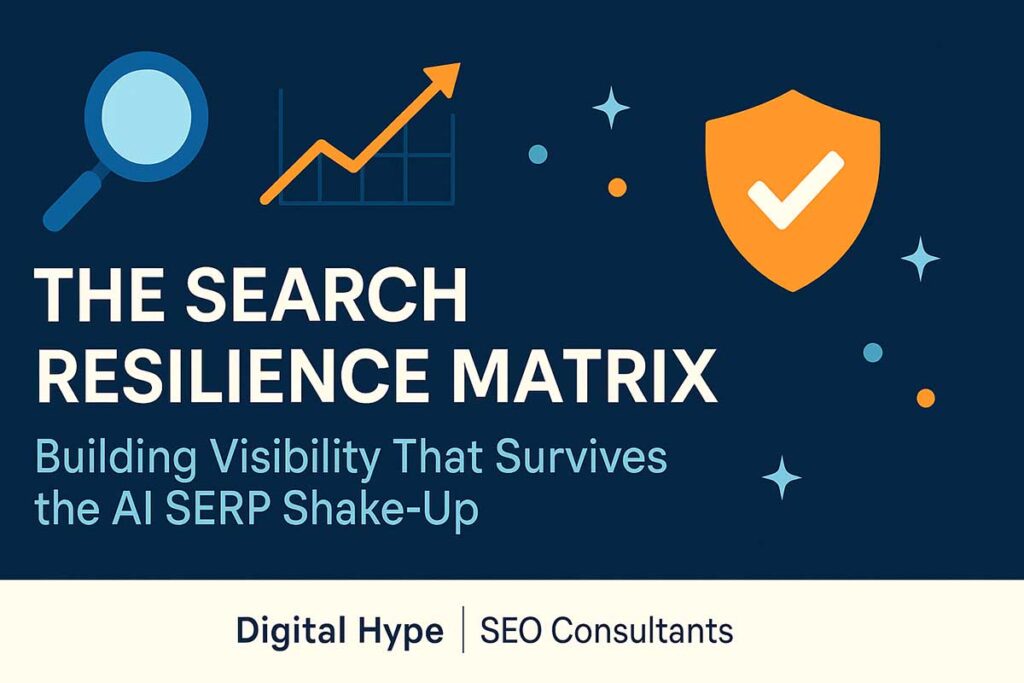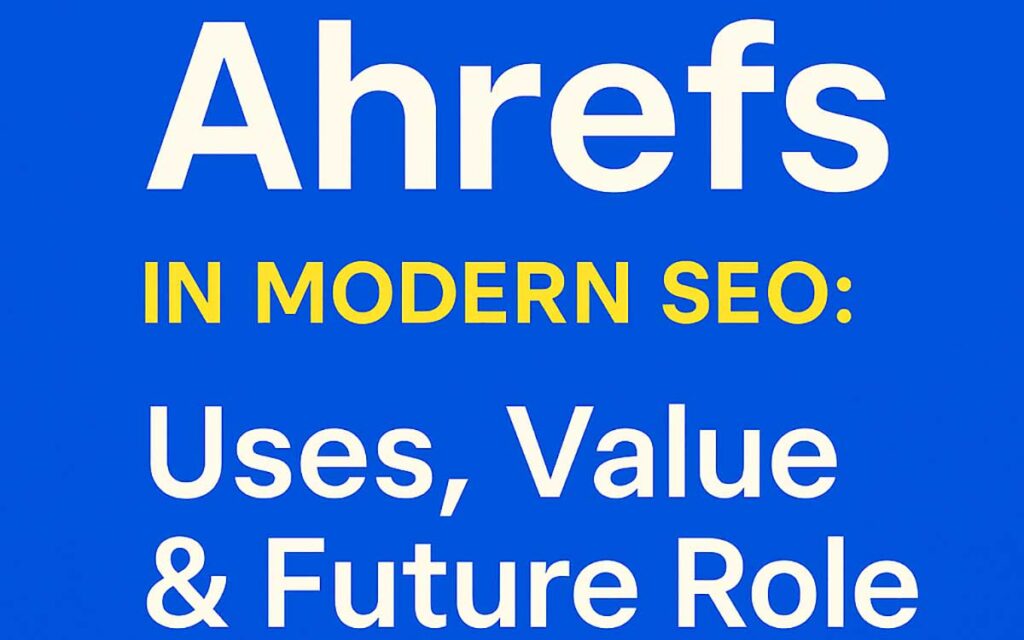SEO has always been about chasing visibility. But in 2026, visibility looks nothing like it did a decade ago. Winning one organic spot isn’t enough anymore, not when AI Overviews, People Also Ask boxes, video carousels, and local packs are crowding out clicks before a user ever sees your link.
For agencies, the question isn’t just “how do I rank clients?” but “how do I keep them visible when AI keeps rewriting the rules?”
That’s where the Search Resilience Matrix comes in. Unlike older SEO frameworks that stack tactics in isolation, this approach is about building multi-layered defences and overlapping opportunities. If AI disrupts one channel, others hold the line.
The Search Resilience Matrix Explained
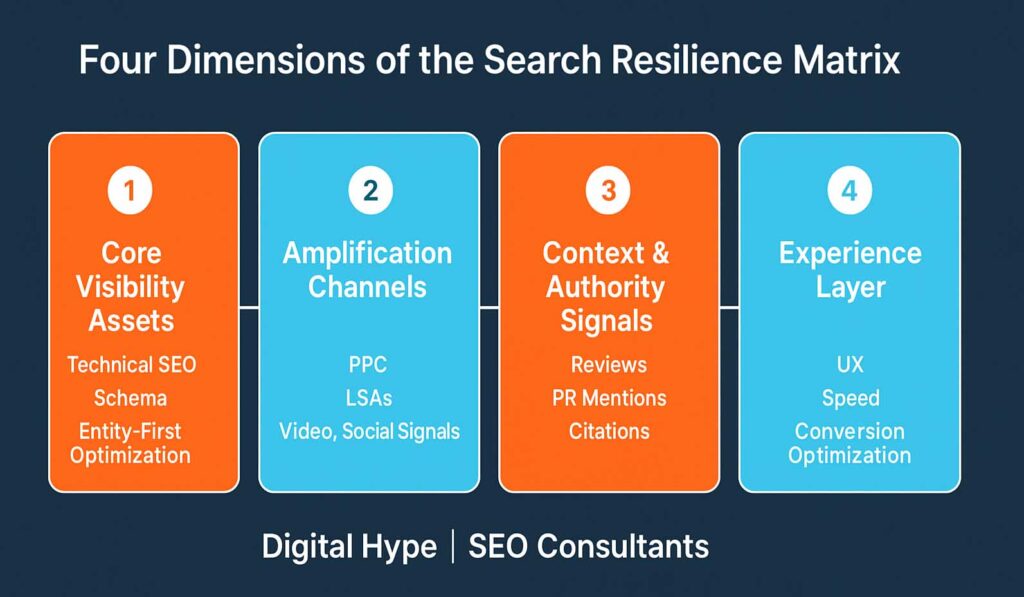
The Search Resilience Matrix is designed to help brands and agencies withstand disruption in the age of AI-driven search. Instead of treating SEO as a single channel, the matrix builds resilience through four interlocking dimensions: Core Visibility Assets, Amplification Channels, Context & Authority Signals, and the Experience Layer. Each reinforces the others, ensuring that if one weakens, the whole system doesn’t collapse.
Why Search Needs a Resilience Model
We’ve been here before.
- In the early 2010s, Panda and Penguin (Google Updates) wiped out entire traffic models overnight.
- In the 2020s, Core Updates and Helpful Content Updates punished thin, low-value content.
But 2025–26 marks the most disruptive shift yet:
- AI Overviews cut organic clicks dramatically. A Pew report suggested CTR drops of nearly 50% when AI summaries appear.
- User journeys fragment. A single query can surface AI answers, snippets, maps, shopping feeds, and video results — all before the website.
- Trust shifts to signals beyond links. AI models weigh consistency across the wider ecosystem as much as they do backlinks. Contradictions or noise in brand data leave space for AI hallucinations.
For agencies, this is the critical point:
– Resilience matters more than rankings. If one layer falters, others must pick up the slack.
Insight: Why Resilience Resonates With Clients
When speaking with clients, agencies often face scepticism about “yet another SEO model.” The power of the Search Resilience Matrix is that it’s not theory; it’s a diagnostic tool. You can map a client against each dimension, highlight gaps (like inconsistent NAPs or missing video presence), and show how fixing those vulnerabilities prevents future traffic collapses.
1. Core Visibility Assets
This is your foundation. Without it, nothing else sticks.
At its core, this layer covers the fundamentals of technical SEO, schema markup, and entity-first optimisation. However, by 2026, agencies will need to treat it as more than just hygiene. AI engines don’t just “read” your site, they model it into structured, machine-readable entities. If that structure isn’t there, you risk being skipped entirely.
What belongs here:
- Technical SEO health – clean crawl paths, no index bloat, stable Core Web Vitals, and optimised sitemaps.
- Schema markup – product, service, organisation, local business, FAQ, and review schemas tied together with entity linking (sameAs to LinkedIn, Crunchbase, Wikipedia). See our guide to Generative Engine Optimisation (GEO) for an explanation of how schema feeds enhance AI search.
- Entity-first optimisation – building pages around who/what/where your business is, not just keywords.
Insight: Going Beyond Basics
Most in-house web optimisation teams stop at schema or Core Web Vitals. SEO consultants can go deeper:
- Log file analysis uncovers crawl waste. We’ve seen enterprise sites burn 20–30% of crawl budget on faceted URLs and outdated archives, invisible to standard audits. Fixing this isn’t glamorous, but it improves indexation and trust.
- Entity reconciliation across platforms is critical. Website owners should check whether Google’s Knowledge Graph displays the correct logo, social profiles, and industry. Any inconsistency feeds AI hallucinations.
- Content embeddings are the new frontier. LLMs interpret meaning semantically, not just through keywords. Agencies need to structure client content in ways that embed cleanly — clear headings, disambiguated terms, and internal linking that reinforces topical clusters.
- Structured performance monitoring – don’t just check if schema is “valid.” Test if it’s being extracted and shown in SERPs, AI overviews, or Knowledge Panels.
Why It Matters
When AI engines cite a source in an overview, it’s because they can trust the structure and context. A site without Core Visibility Assets may still rank occasionally, but it won’t be referenced consistently — and consistency is what resilience demands.
2. Amplification Channels
This is where resilience broadens beyond organic rankings. If you rely solely on traditional SEO, you’re betting everything on a single door staying open, and AI is closing that door more frequently. Amplification Channels give you multiple entry points into the same query space, while also sending reinforcing signals back to AI engines about your brand’s relevance.
What belongs here:
- Paid ads – PPC, LSAs, Shopping Ads.
- Video content – YouTube, Shorts, and video carousel optimisation.
- Social visibility – LinkedIn thought leadership, TikTok snippets, Instagram carousels. See our Social Media Marketing services for how this ties into SEO resilience.
Insight: What Amplification Really Means in 2026
For web businesses, amplification isn’t about “extra exposure”; it’s about creating signals AI engines can’t ignore.
- YouTube snippets in AI Overviews. Gemini and Perplexity increasingly surface video answers for “how to” queries. Agencies can structure video titles and descriptions with schema (VideoObject) to maximise the chances of being cited.
- LinkedIn engagement loops. High-engagement LinkedIn posts are scraped into AI-driven answers. Agencies should track not only impressions and likes, but whether these posts appear in generative summaries.
- Entity-aligned PPC. Running PPC in isolation wastes potential. Agencies can align ad copy, landing pages, and structured data with organic and AI-readable entities — so ads don’t just convert, they reinforce brand context.
- Diversifying format = diversifying trust. A blog post and a TikTok clip about the same service create different validation vectors. AI engines look for that multi-format reinforcement before deciding a brand is credible enough to cite.
Why It Matters
Amplification isn’t just “extra marketing spend.” It’s part of the resilience net. When organic clicks fall because AI overviews answer queries directly, your brand can still appear in video snippets, paid placements, or as a cited thought leader. Every channel reinforces the entity web around you, precisely what AI engines rely on to deliver accurate results.
Ready to Strengthen Your Search Resilience?
Don’t wait for AI updates to disrupt your visibility. At Digital Hype, we help businesses in Bournemouth, Poole, Dorset — and across the UK — build SEO strategies that survive and thrive in the AI search era.
Explore Our SEO & AI SEO Services →3. Context & Authority Signals
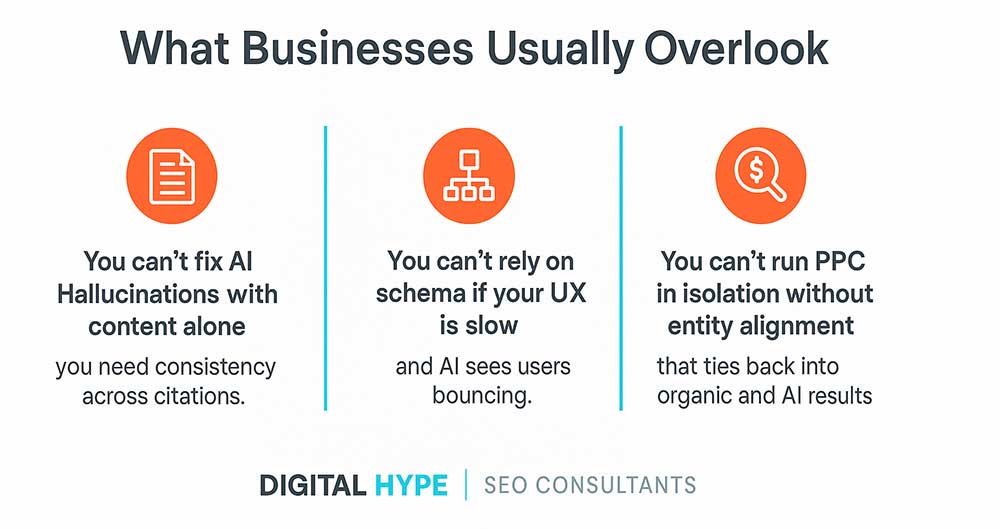
This is the dimension most businesses, and many search agencies, overlook. AI engines don’t just crawl your site. They read the entire web about you. If what they find is inconsistent, incomplete, or contradictory, they fill the gaps with guesswork. That’s how hallucinations happen.
What belongs here:
- Reviews and citations – Google Business Profile, Trustpilot, G2, Yelp, industry-specific platforms.
- Press mentions – national and local news, trade press, and authoritative blogs.
- Consistent NAP data – across directories, from Yell and 192 to niche vertical listings.
- Brand authority – thought leadership content, expert commentary, and content marketing assets.
Insight: Controlling the Ecosystem
Here’s where website owners can add real value beyond a standard SEO campaign:
- Conflicting NAP = AI confusion. A client might have 20+ directory listings across Yell, Yelp, 192, FreeIndex, local chambers, and sector-specific sites. If even one uses an old phone number or address, AI models flag it as a conflict.
- Tier-2 directories still matter. Everyone fixes Google Business Profile, but AI engines scrape beyond the obvious. Good SEO agencies that clean up secondary and niche platforms prevent “drift” in how brands are represented.
- Press mentions feed AI training. LLMs are trained on news and authoritative sources. A single trade press feature or local news article can shift how a brand is described in AI summaries.
- Semantic co-occurrence builds authority. If your brand is repeatedly mentioned alongside trusted entities, AI engines pick up on that clustering. Search engine optimisation companies can deliberately seed these associations.
- Review signals matter more than volume. A steady flow of authentic, context-rich reviews (mentioning service areas, industries, or expertise) does more for AI trust than a flood of generic 5-stars.
Why It Matters
Context prevents misrepresentation. If your site says one thing, but directories, reviews, and press say another, AI engines fill the gap with errors, and your brand loses credibility. Agencies that manage the noise beyond the website not only improve visibility but also protect clients from being written out of the AI conversation altogether.
4. Experience Layer
Clicks still matter, but conversions matter more. A resilient search strategy doesn’t stop at visibility. It ensures that when someone does reach your site, the experience builds trust and drives action. This is the shock absorber in the matrix: even if traffic volumes fall, every visitor you keep converts at a higher rate.
What belongs here:
- Fast, mobile-first performance – instant loading, stable Core Web Vitals, and zero frustration.
- Clear UX pathways – navigation that matches user intent without friction.
- Conversion-optimised landing pages – tailored to AI and PPC queries, not just generic keywords.
Agency Insight: Why Experience Is Now an SEO Signal
For SEO agencies, this layer isn’t just CRO — it’s search resilience in action.
- AI interprets bounce behaviour. If users pogo-stick (click → bounce → re-query), AI engines see it as a sign of low trust.
- Landing pages aligned to AI phrasing. AI Overviews use a different language from traditional queries. Search agencies can map those phrases into landing page copy, ensuring alignment with how AI frames intent.
- Schema + CRO integration. Agencies can mark up CTAs, FAQs, and reviews on conversion pages.
- Micro-conversions feed resilience. Tracking form fills, downloads, and scroll depth proves to AI that intent was satisfied.
- Mobile UX as default. AI results are mobile-first. A poor small-screen experience will cut resilience in half.
Why It Matters
Agencies have long sold “traffic growth.” In 2026, traffic is only half the story. The Experience Layer ensures that whatever traffic survives AI disruption works harder, converting more consistently, signalling satisfaction to AI engines, and reinforcing trust for future rankings and citations.
Measuring Search Resilience
Traditional SEO reporting, rankings, traffic, and impressions are no longer enough. In the AI search era, agencies must demonstrate resilience by showing how visibility is maintained across multiple entry points, even when organic CTRs drop.
What to measure:
- AI citations – Track when and how often your brand is referenced in AI Overviews, Gemini snapshots, or Perplexity answers.
- SERP coverage – Map how many entry points (ads, local pack, PAA, video, organic, AI box) your client owns per query.
- Engagement quality – Measure not just visits, but conversions, micro-conversions (scroll depth, form starts), and bounce patterns.
- Authority signals – Monitor press mentions, directory consistency, and review velocity across the ecosystem.
Insight: Building a Resilience Scorecard
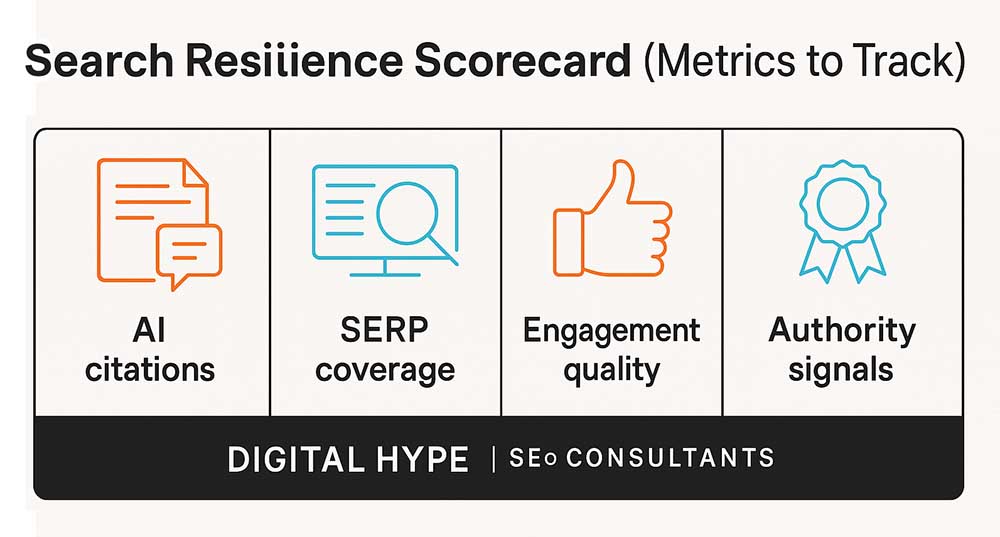
Agencies can differentiate themselves by building a Search Resilience Scorecard for clients. This could include:
- Entity recall rate – percentage of test queries where the brand appears in AI or Knowledge Graph.
- Coverage index – number of SERP features owned per priority query.
- Cohesion audit – consistency across schema, NAP, and third-party mentions.
- Conversion resilience – performance of top landing pages when organic traffic dips.
By packaging these into a client-facing report, search agencies demonstrate not only visibility but also durability.
Example Scenario
A mid-size UK retailer that relied almost entirely on organic rankings. When AI Overviews rolled out more aggressively, their CTR fell by 35% in just three months.
Instead of chasing new keywords, they:
- Expanded schema markup to clarify product and brand entities.
- Shifted part of the ad budget into YouTube video and PPC for high-intent search terms.
- Cleaned up conflicting directory listings, especially secondary ones like 192 and industry-specific catalogues.
- Rebuilt top-performing landing pages centred on AI-phrased intent and optimised page speed for mobile devices.
Within a quarter, their visibility footprint, measured across organic clicks, AI mentions, and ad placements, had grown, even though organic traffic had not returned to pre-AI levels.
Insight: Vertical Variations
Different industries show resilience differently, and agencies need to adjust strategy accordingly:
- Retail / eCommerce – product schema, shopping ads, and video demos feed resilience.
- B2B SaaS – thought leadership, LinkedIn visibility, and consistent PR mentions matter most.
- Local services (law, dental, trades) – NAP accuracy, Google Business Profile optimisation, and authentic review signals dominate.
SEO firms that map clients into these vertical-specific resilience patterns show not just competence, but foresight.
What Matters Most
The search landscape of 2026 isn’t just more competitive, it’s more unpredictable. Frameworks that rely on a single “pillar” of traditional SEO will continue to break every time Google or an AI engine shifts the rules.
The Search Resilience Matrix is different. It’s about designing an ecosystem that bends but doesn’t break. When one layer falters, whether that’s organic CTR, PPC costs, or directory consistency, the others hold. That’s how you stay visible, trusted, and chosen in the age of Generative AI.
Agency Insight: Making the Matrix a Sales & Strategy Tool
For agencies, this isn’t just a model, it’s a conversation framework:
- In audits, map clients against the four dimensions and highlight weak spots.
- In pitches, use the matrix to explain why SEO alone is no longer sufficient.
- In retainers, track resilience metrics (AI citations, SERP coverage, authority signals) alongside traditional KPIs.
- In strategy, use the matrix to prioritise actions: fix the foundations, diversify amplification, clean up authority signals, and optimise experience.
The beauty of the model is its flexibility: it works for retailers, SaaS providers, local services, and global brands alike. Clients understand it quickly, and agencies can use it to move conversations away from rankings and towards resilience.
Search Resilience Matrix – FAQs
What is the Search Resilience Matrix in simple terms?
It’s a practical framework to keep your business visible even when AI changes how search results are shown. Instead of relying only on Google rankings, it spreads visibility across four layers so one disruption can’t wipe you out.
Why should small businesses and consultants care about search resilience?
AI answer boxes often appear before website links. If you rely only on rankings, clicks can drop quickly. A resilience strategy ensures people still see and trust your brand across multiple entry points.
How does the matrix help SMEs generate more leads?
It combines strong SEO foundations with paid ads, reviews/mentions, and better user experience. That means more chances to appear (and convert) via organic results, AI overviews, local packs, videos, and ads.
Is this approach only for large companies?
No. SMEs and independent consultants often benefit most. Cleaning up directory listings, securing steady reviews, and aligning Google Business Profile with your site are high-impact, affordable starting points.
How long before I see results?
Most businesses notice improved visibility within 3–6 months. The bigger payoff is durability: resilience reduces the risk of sudden traffic loss after AI or Google updates.
Does the Search Resilience Matrix replace traditional SEO?
No. SEO remains the foundation. The matrix ensures SEO, PPC, social visibility, reviews, and UX work together rather than in silos.
How can agencies or consultants use the matrix with clients?
Map each client against the four dimensions, highlight weak areas (e.g., inconsistent citations or missing video presence), and prioritise fixes that add the most resilience first.
What’s the ROI of building search resilience?
More consistent visibility, steadier lead flow, and protection against single-channel shocks. Instead of chasing short-term ranking wins, you build trust signals that compound across AI and traditional search.
Resilience as the New SEO Standard
Search in the AI era is volatile, but volatility creates opportunity for those prepared to adapt. The agencies that thrive won’t be the ones chasing the next keyword trend or waiting for the next algorithm update — they’ll be the ones that build resilience into every layer of their clients’ visibility.
The Search Resilience Matrix is more than a framework. It’s a mindset shift:
- Away from ranking obsession, towards ecosystem strength.
- Away from one-channel dependency, towards multi-channel reinforcement.
- Away from fragile strategies, towards durable visibility that bends but doesn’t break.
SEO agencies and consultants that embrace this shift will do more than protect client traffic; they will expand trust, authority, and presence across AI-driven search landscapes. That’s how you move from simply being visible today to becoming the brand AI chooses to surface tomorrow.
Ready to Strengthen Your Search Resilience?
Don’t wait for AI updates to disrupt your visibility. At Digital Hype, we help businesses in Bournemouth, Poole, Dorset — and across the UK — build SEO strategies that survive and thrive in the AI search era.
Explore Our SEO & AI SEO Services →
